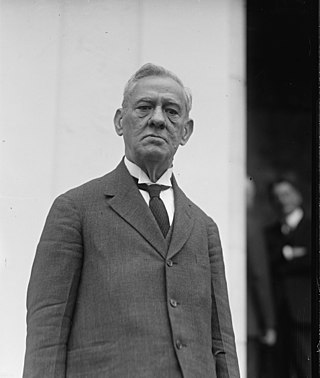
Alfredo de Zayas y Alfonso, usually known as Alfredo de Zayas under Spanish naming customs and also known as Alfredo Zayas, was a Cuban lawyer, poet and political figure. He served as prosecutor, judge, mayor of Havana, secretary of the Constitutional Convention, Senator in 1905, president of the Senate in 1906, Vice President of Cuba from 1909 to 1913 and President of Cuba from May 20, 1921, to May 20, 1925.

Gerardo Machado y Morales was a general of the Cuban War of Independence and President of Cuba from 1925 to 1933.

José Miguel Gómez y Arias was a Cuban politician and revolutionary who was one of the leaders of the rebel forces in the Cuban War of Independence. He later served as President of Cuba from 1909 to 1913.
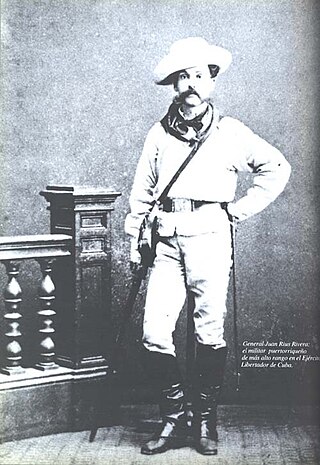
General Juan Rius Rivera, was the soldier and revolutionary leader from Puerto Rico to have reached the highest military rank in the Cuban Liberation Army and to hold Cuban ministerial offices after independence. In his later year, he also became a successful businessperson in Honduras.
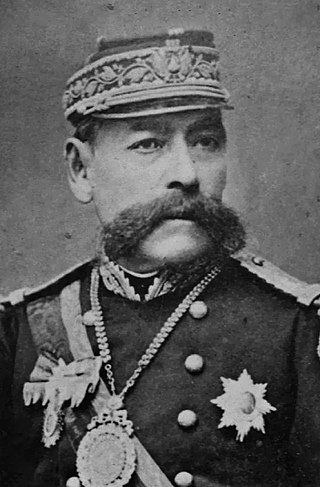
Narciso Campero Leyes was a Bolivian general and politician who served as the 20th president of Bolivia from 1880 to 1884. The Narciso Campero Province was named after him.

Cruces is a municipality and town in Cienfuegos Province, Cuba. It is the home of the Mal Tiempo National Park which commemorates a battle in the 1895 War of Independence.
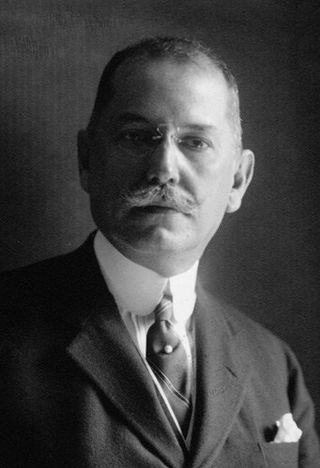
Cosme de la Torriente y Peraza was a Cuban soldier, politician, lawyer and statesman.

Francisco Burdett O'Connor was an officer in the Irish Legion of Simón Bolívar's army in Venezuela. He later became Chief of Staff to Antonio José de Sucre and Minister of War of Bolivia. Aside from Bolívar and Sucre, he is one of the few military officers of the Spanish American wars of independence to be bestowed the title of Libertador (Liberator).
Juan Procopio de Bassecourt Thieulaine y Bryas López de Ochoa, was Baron of Maials, Count of Santa Clara an office he assumed before the Spanish Cession enacted by the Adams-Onís Treaty of 1819, Captain General of Cuba, and Captain General of Catalonia. While he was Captain General of Cuba he was responsible for the construction or improvement of numerous fortifications in Havana, including the Santa Clara Battery.

Zayas is an old Castilian noble family, that has its ancestral seat in a place called Zaya in the province of Soria, from where the family took its name. The word Zayas has its origin in the Basque word Zai, meaning watchman or guard.
José María Coppinger was a Spanish soldier who served in the infantry of the Royal Spanish Army (Ejército de Tierra) and governed East Florida (1816–1821) and several areas in Cuba including Pinar Del Río, Bayamo, the Cuatro Villas and Trinidad at various times between 1801 and 1834. He was also a member of the Royal and Military Order of Saint Ferdinand and San Hermenegildo.
Zayas is a Castilian surname rooted in the toponym of the same name, which itself derives from the Basque word zai, meaning watchman or guard.

Pedro Betancourt Dávalos (1858–1933) was a medical doctor, major general, diplomat, Secretary of Agriculture, politician, and Cuban revolutionary in the Cuban War of Independence.

Barrio de San Lázaro is one of the first neighbourhoods in Havana, Cuba. It initially occupied the area bounded by Calle Infanta to the west, Calle Zanja to the south, Calle Belascoáin to the east, and the Gulf of Mexico to the north, forming the western edge of Centro Habana. According to the 1855 Ordenanzas Municipales of the city of Havana, Barrio San Lázaro was the Tercer Distrito and was Barrio No. 8.
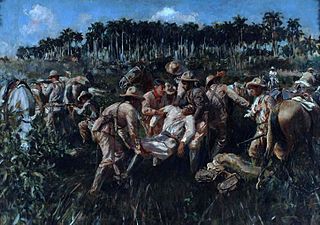
The Battle of San Pedro was a battle of the Cuban War of Independence that took place on December 7, 1896 within the vicinity of the farm of the same name. The battle occurred near the town of Punta Brava on the outskirts of Marianao, La Habana Province.

Vega Alta is a ward and town in Camajuaní, Villa Clara, Cuba and a ward. It is in the vicinity of the Sagua la Chica River, and bordering the ward are the wards of Constancia, Aguada de Moya, Carmita, and Batalla de Santa Clara.

Francisco Carrillo Morales (1851–1926) was a Cuban politician and general who participated in all three wars of Cuban Independence. He commanded the 4th Army Corps during the Cuban War of Independence as a Major General. He was also known as the 6th Vice President of Cuba from May 20, 1921, to May 20, 1925, as well as a governor of several Cuban provinces.

The Cuban Liberation Army, colloquially known as the Mambí Army was an insurgent army which was formed in the last third of the 19th century and fought for independence from Spain and the abolition of slavery. It first saw combat in the Ten Years' War (1868–1878) under the command of Carlos Manuel de Céspedes, Ignacio Agramonte, and Carlos Roloff. The independentists were decentralized and operated within their own regions autonomously of each other, until the Assembly of Guáimaro established the Republic-in-Arms of Cuba and the Liberation Army's command structure. After the Pact of Zanjón, a brief uprising called the Little War saw Major-Generals Calixto García and Antonio Maceo lead the Army of Liberation in another attempt at independence and the abolition of slavery, though unsuccessfully. Finally, during the War of Independence, the Liberation Army was once again organized to fight against the Spanish colonial government. The Liberation Army would reach its highest count of active members in the Spanish-American War, when an imminent Cuban-American victory caused hitherto anti-independence elites to join the Liberation Army. These recruits were nicknamed "Sunflowers" because they "point to where the sun is shining".

Eusebio Hernández Pérez was a Cuban eugenicist, obstetrician, and mambí in the Ten Years' War, Little War, and Cuban War of Independence. He reached the rank of brigadier general in the Ejército Mambí and was professor at the University of Havana. Sarduy Nápoles named him "The Father of Cuban Obstetrics". He and Domingo Ramos Delgado posited the idea of homiculture, which integrated into the eugenics movement with the two diverging in thought.

Guerrero is a rural barrio in Camajuani, Cuba.



















